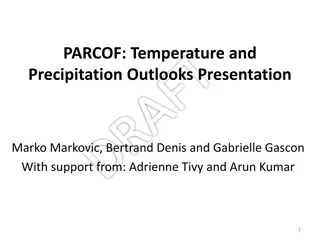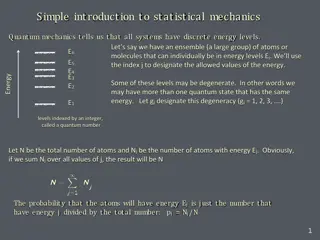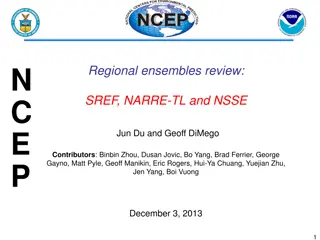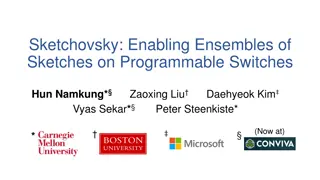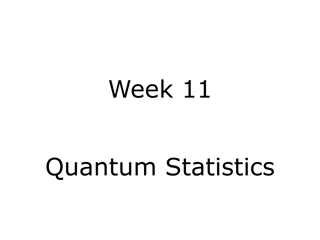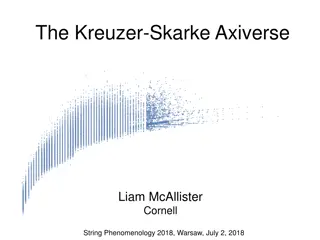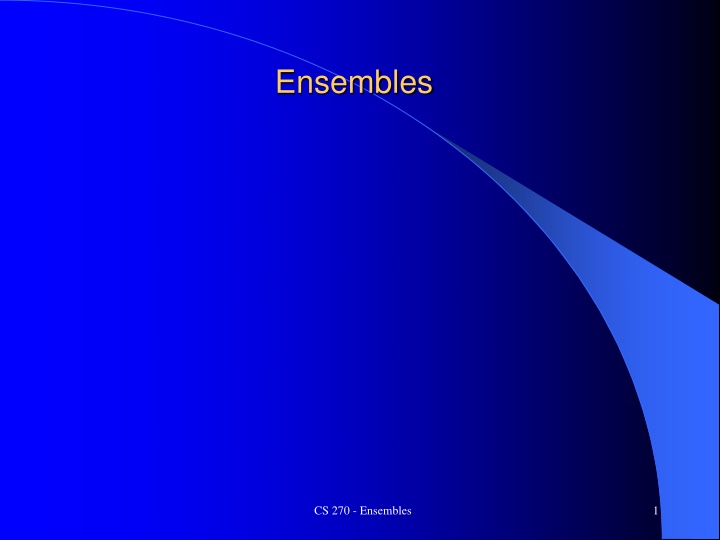
Ensembles in Machine Learning
Dive into the world of ensembles in machine learning, where multiple diverse models come together to enhance accuracy and reduce errors. Learn how ensembles tackle bias and variance issues in learning models, and explore various ensemble approaches such as Bagging, Boosting, and more. Discover the scriptural inspiration behind ensembles and the importance of making decisions based on collective wisdom.
Download Presentation

Please find below an Image/Link to download the presentation.
The content on the website is provided AS IS for your information and personal use only. It may not be sold, licensed, or shared on other websites without obtaining consent from the author. If you encounter any issues during the download, it is possible that the publisher has removed the file from their server.
You are allowed to download the files provided on this website for personal or commercial use, subject to the condition that they are used lawfully. All files are the property of their respective owners.
The content on the website is provided AS IS for your information and personal use only. It may not be sold, licensed, or shared on other websites without obtaining consent from the author.
E N D
Presentation Transcript
Ensembles CS 270 - Ensembles 1
A Holy Grail of Machine Learning Outputs Just a Data Set or just an explanation of the problem Automated Learner Hypothesis Input Features CS 270 - Ensembles 2
Ensembles Multiple diverse models (Base Models) are trained on the same task and then their outputs are combined to come up with a final output Most commonly base models are variations of the same ML algorithm with different training sets or hyperparameters The specific overfit of each base model can be averaged out If models are diverse (uncorrelated errors) then even if the individual models are weak generalizers, the ensemble can be very accurate Many different Ensemble approaches Bagging, Boosting, Stacking, Gating/Mixture of Experts, Wagging, Mimicking, Heuristic Weighted Voting, Combinations Combining Approach M1 M2 M3 Mn CS 270 - Ensembles 3
Ensembles are Scriptural Mosiah 29:26, 27 Now it is not common that the voice of the people desireth anything contrary to that which is right; but it is common for the lesser part of the people to desire that which is not right; therefore this shall ye observe and make it your law--to do your business by the voice of the people. And if the time comes that the voice of the people doth choose iniquity, then is the time that the judgments of God will come upon you; yea, then is the time he will visit you with great destruction even as he has hitherto visited this land. CS 270 - Ensembles 4
Bias vs. Variance Learning models can have error based on two basic issues: Bias and Variance "Bias" measures the basic capacity of a learning approach to fit the task "Variance" measures the extent to which different hypotheses trained using a learning approach will vary based on training set variations and hyperparameters MLPs trained with backprop have low bias error because they can fit tasks well, but can have relatively high variance error because each model might fall into odd nuances (overfit) based on training set choice, initial weights, and other parameters Typical with the more complex models Na ve Bayes has high bias error (doesn't fit that well), but has no variance error We would like low bias error and low variance error Ensembles using multiple trained models with high-variance and low-bias error can average out the variance, leaving just the bias CS 270 - Ensembles 5
Some classifiers GAUSSIAN QUADRATIC LINEAR BAYES MULTILAYER NEURAL NETWORK SIMPLE PERCEPTRON NEAREST NEIGHBOR SUPPORT VECTOR MACHINE 6 CS 270 - Ensembles
Amplifying Weak Learners Combining weak learners Assume n induced models which are independent of each other with each having accuracy of about 60% on a two class problem. While one model is not dependable, if a majority of a group of these lean in one direction, then we can have higher confidence. If all n give the same class output then you can be confident it is correct with probability 1-(1-.6)n. For n=10, confidence would be 99.4%. Normally not independent (e.g. similar training sets). If all n were the same hypothesis, then no advantage could be gained. Also, unlikely that all n would give the same output, but if a majority did, then still get an overall accuracy better than the base accuracy of the models If m models say class 1 and w models say class 2, then P(majority_class) = 1 Binomial(n, min(m,w), .6) n! r!(n -r)!pr(1- p)n-r P(r) = CS 270 - Ensembles 7
Bagging Bootstrap aggregating (Bagging) Induce n learners using the same initial parameters Each training set is chosen uniformly at random with replacement from the original data set, training sets might be 2/3rds of the data set still need to save some separate data for testing All n hypotheses have an equal vote for classifying novel instances Great way to improve overall accuracy by decreasing variance. Consistent significant empirical improvement Does not overfit (whereas boosting may), but may be more conservative overall on accuracy improvements Bigger n the better (diminishing), but need to consider efficiency trade-off Typically used with the same learning algorithm and thus best for those which tend to give more diverse hypotheses based on initial random conditions Could use other schemes to improve the diversity between learners Different initial hyperparameters, sampling approaches, etc. Different learning algorithms The more diversity the better - (yet often used just with the same learning algorithm and different training subsets) CS 270 - Ensembles 8
Boosting - AdaBoost Boosting by resampling - Each TSt is chosen randomly with distribution Dt with replacement from the original training data. D1has all instances equally likely to be chosen. Typically each TSt is the same size as the original data set. Induce first model. Change Dt+1 so that instances which are mis-classified by the current model on its current TS have a higher probability of being chosen for future training sets. Keep training new models until stopping criteria met n models induced not best approach Overall Accuracy levels out on validation set Most recent model has accuracy less than 50% on its TS All models vote, but each model s vote is scaled by its accuracy on the training set it was trained on Boosting is more aggressive than bagging on accuracy but in some cases can overfit and do worse can theoretically converge to training set On average better than bagging, but worse for some tasks In rare cases can be worse than the non-ensemble approach Bagging can be trained in parallel, Boosting requires sequential training CS 270 - Ensembles 9
Boosting Another approach to boosting is to have each base model train on the entire training set but have the ML algorithm take each current instance weighting into account during learning. How might you do that for MLPs Decision Trees k-NN Then still have final models vote each weighted by its accuracy CS 270 - Ensembles 10
Boosting Another approach to boosting is to have each base model train on the entire training set but have the ML algorithm take each current instance weighting into account during learning. How might you do that for MLPs Scale learning rate by weight Decision Trees instance membership is scaled by weight k-NN node vote is scaled by weight Then still have final models vote each weighted by its accuracy CS 270 - Ensembles 11
Ensemble Creation Approaches A good goal is to get less correlated errors between models Injecting randomness initial weights, different learning parameters, etc. Different Training sets Bagging, Boosting, different features, etc. Different subset of features for each model Forcing differences different objective functions, auxiliary tasks Different machine learning models Obvious, but surprisingly it is used less often More work to get all the models running, creating compatible data formats, etc. One aspect of COD (Classifier Output Distance) research - which algorithms are most different and thus most effective to ensemble CS 270 - Ensembles 12
Ensemble Combining Approaches Unweighted Voting (e.g. Bagging) Weighted voting based on accuracy, etc. (e.g. Boosting) Stacking - Learn the combination function Higher order possibilities Which algorithm should be used for the stacker Must match the input/output data types between models Stacking the stack, etc. Gating function/Mixture of Experts The gating function uses the input features to decide which expert or combination (weighted) of experts to use in the vote with experts being strong in different parts of the input space Heuristic Weighted Voting differs for each instance CS 270 - Ensembles 13
Brief Intro to Gradient Boosting Often used with decision trees and regression Common winner in task competitions Train first model F1 with the basic training set Train next model h creating updated ensemble model Fm+1 = Fm+ h But, train h using the residual/error (the difference between the target and the current output of Fm) For h, change training instance (x,y)to(x, y - Fm(x)) Each new model learns to output and cancel the remaining error from the previous model, leaving less error with each model Learning focuses on instances where the latest Fm has higher error Also learns each model s weighting coefficient with gradient descent to minimize chosen loss function (SSE common) Once trained, Fm no longer changes, and we keep adding new h s until remaining error is almost gone or test error begins to increase Final output is the weighted sum of the models CS 270 - Ensembles 14
Gradient Boosting Training CS 270 - Ensembles 15
Brief Intro to Gradient Boosting How to combine? Each model s weighting/voting coefficient i is learned with gradient descent to minimize loss as models are created, then frozen XGBoost eXtreme Gradient Boosting a popular and successful software library for efficient parallel gradient boosting implementations CS 270 - Ensembles 16
An Example of Gradient Boosting 1) Fit a shallow regression tree T1 to the data the first model is ?1 = ?1 The shortcomings of the model are given by the negative gradients. 2) Fit a tree T2 to the negative gradients The second model is: ?2 = ?1 + ??2?2 ? is a learning rate (e.g. .1) to encourage more models ?i is optimized, then frozen, so that ?i best fits the data 3) Continue adding models (trees) until stopping criteria met 4) The final model is ?final = ?final-1 + ??final ?final CS 270 - Ensembles 17
Gradient Boosting Notes Avoid overfit (and maintain relatively weak models) by: Tree constraints (e.g. max depth usually 4-8) Tree models learn different for each leaf node Stochastic Gradient Boosting - rows and/or columns dropped for current TS commonly creating TS for h by choosing 50% of DS without replacement Shrinkage new h s scaled by smaller learning rate (e.g. .1), leading to a larger number of iterative models (slower learning but better generalization) Early stopping (validation set) Regularization - Standard L1 and L2 on weight magnitudes CS 270 - Ensembles 18
Dropout Overfit avoidance For each instance during training temporarily drop any hidden or input node and its connections with probability p and then train Final network just has all averaged weights (actually scaled by 1-p since that better matches the expected values at training time) Works as if ensembling 2n different network substructures Lots of other variations Dropconnect, etc. CS 270 - Ensembles 19
Ensemble Summary Other Models Random Forests, Boosted stumps, Cascading, Arbitration, Delegation, PDDAGS (Parallel Decision DAGs), Bayesian Model Averaging and Combination, Clustering Ensemble, etc. End-to-end ensembles, combiner participates in base model training Efficiency Issues Wagging (Weight Averaging) - Multi-layer? - Dropout Mimicking - Oracle Learning, semi-supervised Great way to decrease variance/overfit Almost always gain accuracy improvements with Ensembles CS 270 - Ensembles 20
Oracle Learning CS 270 - Ensembles 21









